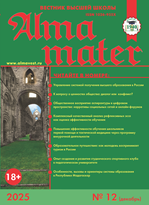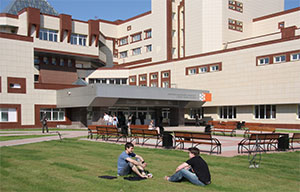UDC 303:004.77
https://doi.org/10.20339/AM.02-21.106
K.A. Malyshenko is Cand.Sci. (Economics), Ass. Prof. at sub-faculty “Finance and Credit” e-mail: konstantinanatolevicmalysenko@gmail.com; and D.V. Anashkin is student. Вoth at Humanitarian and Pedagogical Academy —branch of Crimean Federal University n.a. V.I. Vernadsky, Yalta, Russia
Analyzed is the problem of predicting the mood of users in social networks. The properties of social network information objects are investigated, and a method for collecting and processing social data for forecasting is presented. The goal of this study is to prove or disprove the possibility of predicting user sentiment in social networks. A discrete model of the social network has been compiled. The theoretical foundations of forecasting are formulated based on the statistical characteristics of the discrete model, as well as algorithms for searching and systematizing information objects. A method is proposed and described that allows you to predict the reaction of users to a message published in a social network. A hypothesis about the possibility of predicting mood in social networks is formulated and proved. The possibility of forecasting user sentiment in social networks is proved. A new method that allows you to predict the reaction of users to a published news item is presented based on the principles of machine learning. The results of the work can be applied in the field of small and medium-sized businesses when directly searching for a target audience to increase the profitability of the enterprise. The development of sentiment analysis methods will allow planning measures to contain or speed up the spread of messages. Also, the application value in developing a forecasting model may lie in the development of news sources or identifying trends. The scientific significance of the work lies in the presentation of a method that allows predicting the reaction of social network users to the published news. The results of this work can be used to improve the performance of social networks and to solve the problem of “cold” start (what to show to new users).
Key words: dynamic statistical models, social data, computational linguistics, machine learning, content analysis.
References
1. Akhmetova, A.Zh. Problems of analysis of computer social networks. In: Questions of technical and physical and mathematical sciences in the light of modern research. Collection of articles based on the materials of the VII–VIII international scientific and practical conference. Moscow, 2018. P. 9–15.
2. Batura, T.V., Murzin, F.A., Proskuryakov, A.V. Software complex for data analysis from social networks. In: Software products and systems. International scientific and practical journal. 2015. No. 4. P. 188–197.
3. Bogdanov, A.L., Dulya, I.S. Sentiment analysis of short Russian-language texts in social media. Bulletin of Tomsk State University. Serie: Economy. 2019. No. 47. P. 220–241.
4. Gdansky, N.I., Krashennikov, A.M., Konyaev, A.Yu. Research and forecasting of the dynamics of information processes in social networks based on the use of discrete models. Russian State Social University. Serie: Social policy and sociology. 2015. No. 2 (108). P. 40–46.
5. Grinev, D.V., Boyko, D.S., Golub, M.A. Using websites and social networks in e-commerce. S. Kuznets Kharkiv National Economic University, Control systems, navigation and communication. 2018. No. 1 (47). P. 99–104.
6. Dokukha, S.V., Valeeva, D.R. Statistical models for analyzing the dynamics of social networks in education research. Education Issues. 2015. No. 1. P. 201–213.
7. Lebedev, I.V., Karpov, I.A., Los, V.P., Samoletova, K.S. Analyzing machine learning methods to predict the popularity of social media posts. Information security problems. Computer systems. 2018. No. 1. P. 18–25.
8. Lysenko, V.D. Analysis of the sentiment of the text for predicting prices on the stock market. Young Scientist. 2018. No. 22 (208). P. 420–423.
9. Minashkin, V.G., Sadovnikova, N.A., Shmoilova, R.A. Business statistics and forecasting. Moscow: Eurasian Open Institute, 2010.
10. Ostapenko, A.G., Parinov, A.V., Shcherbakov, V.B., Devyashin, A.O., Ostapenko, O.A. The problem of constructing discrete models of information diffusion in social networks. Information and Security. 2017. No. 20 (1). P. 95–100.
11. Polyakova, A.G., Kolmakov, V.V., Mirzabekova, M.Yu. Network analysis of the organization of socio-economic processes. Scientific and technical statements of SPbSPU. Serie: “Economic sciences”. 2019. No. 12 (3). P. 60–73.
12. Popova, E.P., Leonenko, V.N. Predicting user reactions on social networks using machine learning methods. Scientific and technical bulletin of information technologies, mechanics and optics. 2020. No. 1 (1). P. 118–124.
13. Russell, M., Klassen, M. Data Mining. Fetching Information from Facebook, Twitter, Linkedln, GitHub. Moscow: Peter, 2020.
14. Ryazanova, N.Yu., Spertsyan, K.M. Comparative analysis of methods for determining the emotional color of messages in social networks using supervised learning. New information technologies in automated systems. 2018. No. 21. P. 417–423.
15. Sivogolovko, E.V. Methods of generalizing clustering in the analysis of social networks. Software products and systems. International scientific and practical journal. 2011. No. 4. P. 98–101.
16. Kharlamov, A.A., Ermolenko, T.V., Zhonin, A.A. Modeling the dynamics of processes based on the analysis of the sequence of text samples. Engineering Bulletin of the Don. 2013. No. 4 (27). P. 90–95.











.png)






